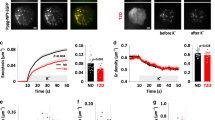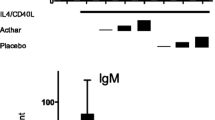Summary
GH3 cell secretory activity was studied in long-term perifusion to define previously reported spontaneous increases in growth hormone (GH) and prolactin production (PRL). Mechanically harvested cells (1×107/column) were perifused at 4 ml/h for 72 h. A basal period of variable duration (8 to 12 h), during which hormone secretion was stable, was followed by steadily increasing secretion rates. Changes in cell number were not sufficient to acount for increased jormone secretion rates: a) there was no significant change in cell count after 72 h (0.97±0.03×107;n=18); b) mean cell column DNA content increased 25.5% above the base value, whereas GH secretion rose 385% and PRL rose 178% (n=5). Observed differences in the duration of the basal secretion period, the basal secretory rate, and the magnitude of secretory rate increase were associated with several variables: a) variablility within a subline was a function of passage number: GH secretion decreased and PRL secretion increased with subculture number; b) cells with identical lot and freeze numbers, but received at different times, behaved differently; c) the presence of an antifungal agent (nystatin) altered hormone secretion reproducibly. Conclusions: a) rates of GH and PRL secretion rise spontaneously in perifusion without a proportional increase in GH3 cell number; b) fluctuations in the rate of GH3 cell secretion of GH and PRL are not entirely random but are determined by several definable variables.
Similar content being viewed by others
References
Aizawa, T.; Hinkle, P. Thyrotropin-releasing hormone rapidly stimulates a biphasic secretion of prolactin and growth hormone in GH4C1 rat pituitary tumor cells. Endocrinology 116:73–82; 1985.
Berkson, J.; Magath, T. B.; Hurn, M. The error of estimate of the blood cell count as made with the hemocytometer. Am. J. Physiol. 128:309–323; 1939.
Bolton, W. L.; Boyd, A. E. III. Evaluation of growth hormone production from GH1 cells in vitro: effect of culture media and time in culture. In Vitro 16:330–336; 1980.
Boockfor, F. R.; Hoeffler, J. P.; Frawley, L. S. Cultures of GH3 cells are functionally heterogeneous: thryotropin-releasing hormone, estrdiol and cortisol cause reciprocal shifts in the proportions of growth hormone and prolactin secretors. Endocrinology 117:418–420; 1985.
Boockfor, F. R.; Hoeffler, J. P.; Frawley, L. S. Estradiol induces a shift in cultured cells that release prolactin or growth hormone. Am. J. Physiol. 250:E103-E105; 1986.
Conway, S.; McCann, S. M.; Krulich, L. On the mechanism of growth hornmone autofeedback regulation: possible role of somatostatin and growth hormone-releasing factor, Endocrinology 117:2284–2292; 1985.
Dorflinger, L.; Schonbrunn, A. Adenosine inhibits prolactin and growth hormone secretion in a clonal pituitary cell line. Endocrinology 117:2330–2338; 1985.
Frazwley, L. S.; Boockfor, F. R.; Hoeffler, J. P. Identification by plaque assay of a pituitary cell type that secretes both growth hormone and prolactin. Endocrinology 116:734–737; 1985.
Hoyt, R. F., Jr.; Tashjian, A. H., Jr. Immunocytochemical analysis of prolactin production by monmolayer cultures of GH3 rat anterior pituitary cells. II. Variation in prolactin content of individual cell colonies, and stimulation with thyrotropin-releasing hormone (TRH). Anat. Rec. 197:153–162; 1980.
Hyclone Laboratories, Inc. Fetal bovine serum: variation in components that influence cell growth and function. Art. Sci. Tissue Culture 5:3–4; 1986.
Kilvik, K.; Furu, K.; Haug, E., et al. The mechanism of 17β-estradiol uptake into prolactin-producing rat pituitary cells (GH3 cells) in culture. Endocrinology 117:967–975; 1985.
Melmed, S.; Carlson, H. E.; Briggs, J., et al. Autofeedback of prolactin in cultured prolactin-secreting pituitary cells. Hormone Res. 12:340–344; 1980.
Metcalf, M. G. Counting cells as DNA: estimation of ovine pituitary cells on Sephadex columns. Anal. Biochem. 151:118–124; 1985.
Sonnenschien, C.; Richardon, U. I.; Tashjian, A. H., Jr. Chromosomal analysis, organ-specific function and appearance of six clonal strains of rat pituitary tumor cells. Exp. Cell Res. 61:121–128; 1970.
Stachura, M. E. Sequestration of an earlyh-release pool of growth hormone and prolactin in GH3 rat pituitary, tumor cells. Endocrinology 111:1769–1777; 1982.
Stachura, M. E.; Tyler, J. M.; Farmer, P. K. Human pancreatic growth hormone-releasing factor-44 (hpGRF-44) differentially stimulates release of stored and newly synthesized rat growth hormone in vitro. Endocrinology 116:699–706; 1985.
Tashjiam, A. H., Jr. Clonal strains of hormone-producing pituitary cells. Methods Enzymol. 58:527–535; 1979.
Tashjiam, A. H., Jr.; Bancroft, F. C.; Levine, L. Production of both prolactin and growth hormone by clonal strains of rat pituitary tumor cells. J. Cell Biol. 47:61–70; 1970.
Tashjian, A. H., Jr.; Yasumura, Y.; Levine, L., et al. Establishment of clonal strains of rat pituitary tumor cells that secrete growth hormone. Endocrinology 82:342–352; 1968.
Zacur, H. A.; Mitch, W. E.; Tyson, T. E., et al. Autoregulation of rat pituitary prolactin secretion demonstrated by a new perifusion method. Am. J. Physiol. 242:E226-E233; 1982.
Author information
Authors and Affiliations
Additional information
Supported by a grant to MES from the National Institutes of Health (AM33388) and in part by the Medical Research Service of the Veterans Administration.
Rights and permissions
About this article
Cite this article
Lapp, C.A., Stachura, M.E., Tyler, J.M. et al. GH3 cell secretion of growth hormone and prolactin increaseases spontaneously during perfifusion. In Vitro Cell Dev Biol 23, 686–690 (1987). https://doi.org/10.1007/BF02620981
Received:
Accepted:
Issue Date:
DOI: https://doi.org/10.1007/BF02620981




